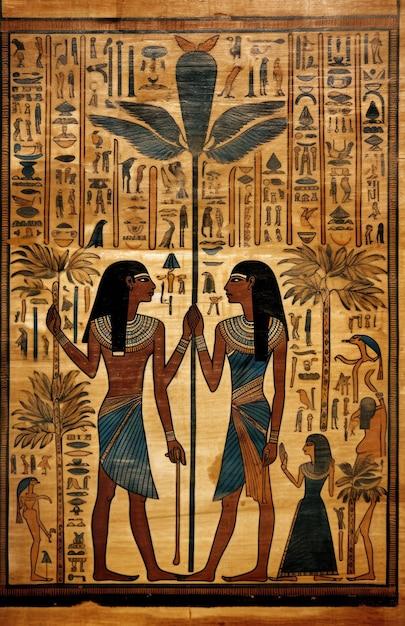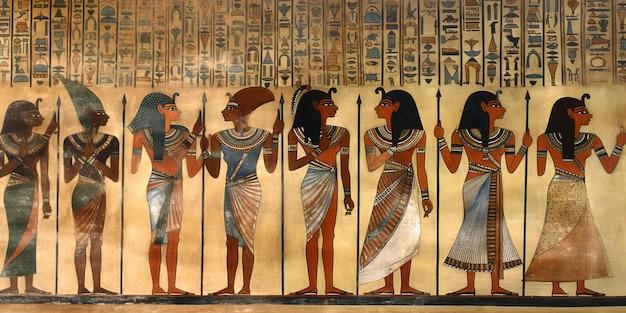Have you ever wondered why all Egyptian art seems to share a similar style? From their monumental sculptures to intricate wall paintings, ancient Egyptian art has a distinct and recognizable aesthetic that has captured the fascination of art enthusiasts and historians for centuries. In this blog post, we will delve into the captivating world of Egyptian art, exploring the reasons behind its consistent appearance and the cultural, historical, and artistic influences that shaped it.
Throughout this article, we will uncover the answers to intriguing questions such as: What materials did Egyptian artists use for their art? Why did they predominantly paint in 2D? What determined a person’s size in an Egyptian painting? Is Egyptian art symmetrical? What makes Egyptian art so special and distinctive? We will also touch upon the purpose of Egyptian art, the fascinating writing system they developed, as well as the techniques they employed to create their iconic representations of humans.
So join us on this journey as we unravel the secrets of Egyptian art, shedding light on the factors that contributed to its enduring legacy and understanding why it remained relatively unchanged throughout the ancient Egyptian period. By the end of this article, you will have a newfound appreciation for the skills, craftsmanship, and symbolism behind these timeless masterpieces.
Why Egyptian Art is So Uniform: A Curious Case of Creativity or Constraint
Egyptian art has captivated people for centuries with its enigmatic beauty and remarkable uniformity. From the intricate burial masks to the majestic statues of pharaohs, there’s an undeniable consistency in style throughout ancient Egyptian artwork. But why does all Egyptian art look the same? Let’s delve deeper into this intriguing phenomenon and uncover the secrets behind it.
The Power of Tradition and Symbolism
Ancient Egypt was a civilization grounded in tradition and deeply rooted in its beliefs. In Egyptian art, symbols were of utmost importance, and adherence to established conventions was the norm. Whether it was the depiction of gods, animals, or everyday scenes, there was a strict set of rules that artists followed to ensure their work conveyed the intended meaning.
Religious Influence and Ritualistic Practices
Religion played a paramount role in ancient Egypt, permeating all aspects of life, including art. The concept of divine order and the belief in an afterlife heavily influenced artistic creation. Art served a purpose beyond mere aesthetic pleasure; it was a means to communicate spiritual ideas, immortalize pharaohs, and facilitate the journey of the deceased to the afterlife.
The Limitations of Hieroglyphics
Hieroglyphics, the ancient Egyptian writing system, also significantly impacted the appearance of Egyptian art. The visual nature of hieroglyphics meant that images and symbols held tremendous power in conveying messages. Artists incorporated hieroglyphic symbols into their artwork, often in a very structured and stylized manner, leading to the uniformity we see in Egyptian art.
Artistic Canon and Technical Skill
The standardization of Egyptian art can also be attributed to the use of an artistic canon, a set of rules and guidelines for proportion and composition. Artists followed strict guidelines and established norms, allowing for continuity and uniformity across different artworks. But don’t be mistaken – this uniformity does not diminish the immense technical skill and craftsmanship exhibited by ancient Egyptian artists.
A Cultural Identity
Another factor contributing to the uniformity of Egyptian art is the strong sense of cultural identity within the civilization. Egyptian society held a profound reverence for tradition and valued the continuity of their cultural heritage. As a result, art underwent gradual evolution rather than dramatic revolutions, preserving the essence of the Egyptian artistic style over centuries.
The striking uniformity of Egyptian art can be attributed to a variety of factors, including religious beliefs, the influence of hieroglyphics, the adherence to artistic conventions, and a strong cultural identity. While this uniformity may seem restrictive at first glance, it speaks to the deep-seated traditions and beliefs that shaped ancient Egyptian civilization. So, the next time you marvel at the splendor of an Egyptian artifact, remember that the consistent style is a testament to the rich heritage and unwavering artistic expression of a civilization that thrived thousands of years ago.
Keyword: uniformity of Egyptian art
FAQ: Why Does All Egyptian Art Look The Same
Ever wondered why all Egyptian art seems to have a similar style? This FAQ is here to unravel the mysteries of Egyptian art and provide answers to your burning questions. From the materials used to the reasons behind their unique style, let’s dive into the captivating world of ancient Egyptian art.
What materials did ancient Egyptian artists use
Ancient Egyptian artists primarily used materials readily available to them, such as papyrus, limestone, wood, clay, and natural pigments. These materials allowed them to create stunning works of art that have stood the test of time.
Why did Egyptians prefer to paint in 2D
The preference for two-dimensional art in ancient Egypt was largely driven by their belief in the afterlife. Egyptians believed that the physical body would perish, but the soul would live on. By painting in two dimensions, they ensured that the depicted forms could be recognized and appreciated by the soul in the afterlife.
What is the name of the art style in ancient Egypt
The art style commonly associated with ancient Egypt is called “Egyptian art” or “Ancient Egyptian art.” This distinctive style is characterized by its formal, symbolic, and timeless representations of human figures and other elements.
What determined a person’s size in an Egyptian painting
The size of a person depicted in an Egyptian painting was determined by their social status or importance. For example, pharaohs would be depicted as the tallest figures, emphasizing their power and divine status, while less prominent individuals would be portrayed at a smaller scale.
Is symmetry a noticeable feature in Egyptian art
Yes, symmetry is a noticeable feature in Egyptian art. The Egyptians placed great importance on balance and harmony, and symmetry played a significant role in achieving this aesthetic. The symmetrically arranged elements in their art were meant to convey a sense of order and stability.
What makes Egyptian art so special
Egyptian art is renowned for its unique characteristics. The combination of vibrant colors, stylized representations of figures, and intricate hieroglyphics creates a visually striking and mesmerizing experience. Additionally, the enduring nature of Egyptian art has allowed us to gain insights into their culture, beliefs, and daily life.
Why are the torso and eye always frontal in Egyptian art
The frontal depiction of the torso and eye in Egyptian art is part of their artistic conventions. It was believed that the most crucial aspects of a person, such as the face and torso, should be shown in the most recognizable way possible. This static front-facing representation was a symbol of eternal existence rather than an attempt at realistic depiction.
What materials were used to build pyramids in ancient Egypt
The pyramids of ancient Egypt were built primarily using limestone blocks, which were plentiful in the region. These massive constructions required immense manpower and engineering skills, showcasing the remarkable achievements of the ancient Egyptians.
Do Egyptians have flat feet
While it’s true that the ancient Egyptians are sometimes depicted with flat feet in their art, this is primarily due to artistic conventions rather than an accurate representation of their physical attributes. It is not an indication that all Egyptians had flat feet.
What is the purpose of Egyptian art
Egyptian art served various purposes, including religious and funerary practices, propaganda, and storytelling. It played a central role in conveying important cultural and religious beliefs, documenting historical events, and ensuring the continuity of their civilization.
Why was Egyptian art not meant to be seen
Contrary to the statement, Egyptian art was indeed meant to be seen. It played a vital role in public spaces, temples, tombs, and even royal palaces, where people could admire and connect with the artistic expressions of their culture.
Why did the pyramid builders create false tunnels and empty rooms
The creation of false tunnels and empty rooms in pyramids was a deliberate architectural strategy to protect the tombs and confuse potential looters. By misleading and disorienting intruders, the builders hoped to safeguard the valuable treasures and sanctity of the resting pharaohs.
Why did Egyptian art remain consistent over time
The consistency in Egyptian art can be attributed to their religious and cultural beliefs, which emphasized tradition, order, and stability. Rather than radical innovation, their artwork focused on preserving the established artistic conventions and maintaining the connection with their ancestral heritage.
What is the name of ancient Egyptian writing
The ancient Egyptian writing system is called hieroglyphics. It features a complex combination of pictorial symbols, phonetic signs, and determinatives to represent words, sounds, and concepts.
Is Anubis the son of Osiris
Yes, in ancient Egyptian mythology, Anubis is often depicted as the son of Osiris and Nephthys. Anubis played a significant role as the god of embalming and the guardian of the afterlife.
How did the Egyptians depict humans in their art
In Egyptian art, humans were depicted in a stylized manner rather than as realistic representations. The figures were typically shown in a composite view, combining a frontal perspective for the upper body and a profile view for the head and legs. This artistic convention allowed for the clearest representation of essential features.
Why are Egyptian drawings flat
The flatness of Egyptian drawings is a distinctive characteristic of their artistic style. This stylistic choice prioritized clarity and symbolism over three-dimensional realism. By using a flat perspective, they could emphasize the important details and meanings in their artwork more effectively.
When did Egyptian art come to an end
While ancient Egyptian art experienced shifts and changes throughout its long history, it endured as a dominant artistic tradition for over three millennia, until around the end of the Ptolemaic period in 30 BCE when Egypt became a Roman province.
Is Egyptian art realistic
The artistic style of ancient Egyptian art was not focused on realistic representation in the same way as Renaissance art, for example. Instead, they emphasized symbolism, formal conventions, and idealized depictions that conveyed the essence and enduring nature of the subject matter.
Explore the captivating world of Egyptian art with these frequently asked questions and gain a deeper appreciation for the remarkable artistic achievements of this ancient civilization. From their materials and techniques to the cultural and religious nuances, Egyptian art continues to intrigue and inspire us to this day. Embrace the timeless allure of these ancient masterpieces and discover the secrets they hold.

